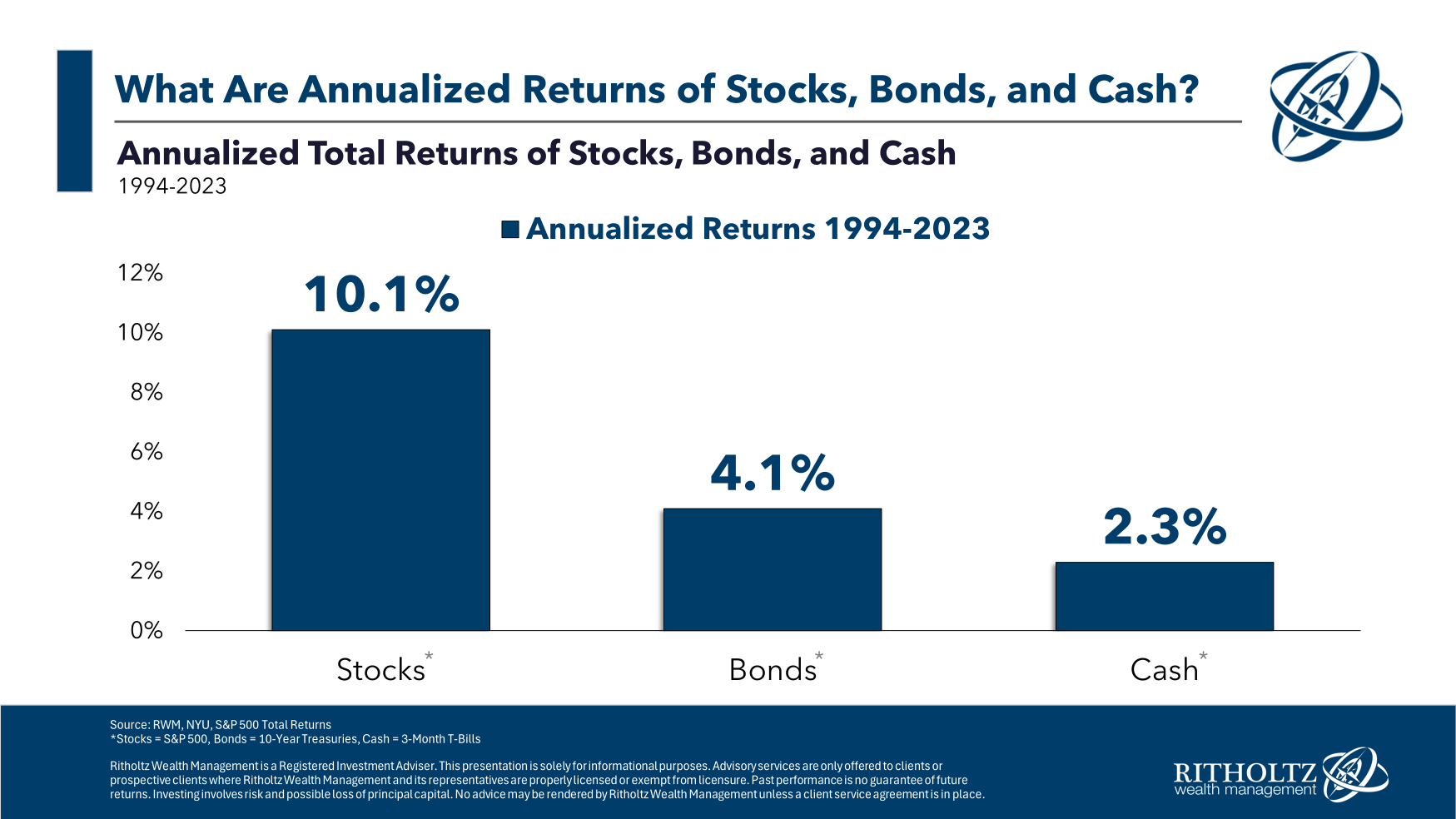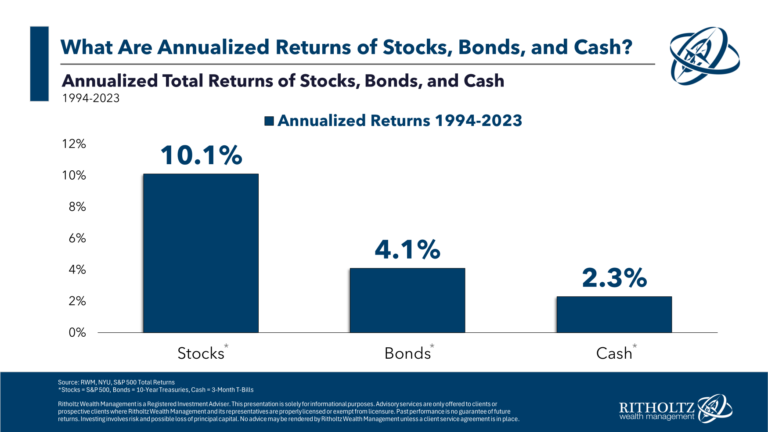A colleague recently asked me to run the 30 year annual returns for U.S. stocks, bonds and cash.
He just wanted the returns. I couldn’t help but slice and dice the numbers and overanalyze the data because that’s what we do here.
Let’s dig in.
First the annual return numbers for the S&P 500, 10 year treasuries and 3 month T-bills over the 30 years ending in 2023:

Some thoughts about these numbers:
Stock returns look average despite the turmoil. From 1994 to 2023, there was the dot-com bubble, a 50% crash, 9/11, a housing bubble, the Great Financial Crisis (which came with another 50%+ crash), a handful of wars, 3 recessions and a pandemic.
And yet…the stock market was up 10% per year.
We had booms and busts, ups and downs, good and bad, but things still turned out OK.
No guarantees about the future but that’s still pretty impressive.
Bond returns weren’t bad despite the bear market. Yields on government bonds have been below average for some time now. We’re still in the midst of the worst bond bear market of all-time.
In 2022 and 2023, 10 year Treasuries were down 22% in total.1
The 5 worst calendar year returns for U.S. government bonds since 1928 have all come in the past 30 years. Three of those five years have occurred since 2009.
Starting yields were higher in the mid-1990s2 and falling rates helped, especially in the first decade of this century.
But 4% returns are not bad considering how weird the yield situation has been for the past 15 years or so.
Cash returns were respectable despite 0% yields for so long. T-bill returns of a little more than 2% per year aren’t great when considering inflation in the 30 years ending 2023 was 2.5% per year.
More than half (16) of the past 30 years have been returns under 2%. Eleven times the returns have been under 1% in a calendar year.
But now T-bill yields are over 5%!
I don’t know how long that’s going to last but it means returns are much higher (for now) than they’ve been in many years.
In fact, the prospects for cash and bonds are both in a much better place than they’ve been in some time.
Here are some more quick-hit stats:
- Stocks were up 80% of the time over the past 30 years. The stock market was down double digits 4 times but up double digits in 19 out of 30 years. Four out of every 10 years the S&P 500 was up 20% or more. The best annual return was +37%. The worst annual return was -37%.
- Bonds were up 80% of the time over the past 30 years. The bond market was down double digits twice (2022 and 2009) and up double digits in 9 years. The best annual return was +24%. The worst annual return was -18%.
- Cash didn’t have a single negative (nominal) year but it also had the worst annual returns over the past 30 years. The best annual return was +6% while the worst return was 0%.
I don’t know what the next three decades will bring but there will likely be recessions, bear markets, geopolitical crises, war, maybe pestilence, and who knows what else.
But I do know that not investing your money guarantees you will fall behind inflation.
And I have a feeling risk will be rewarded with higher returns.
I just don’t know exactly what those returns will be.
They wouldn’t be called risk assets if there was no risk.
Further Reading:
Historical Returns For Stocks, Bonds & Cash
1Meaning yields included.
2Around 6% heading into 1994.
This content, which contains security-related opinions and/or information, is provided for informational purposes only and should not be relied upon in any manner as professional advice, or an endorsement of any practices, products or services. There can be no guarantees or assurances that the views expressed here will be applicable for any particular facts or circumstances, and should not be relied upon in any manner. You should consult your own advisers as to legal, business, tax, and other related matters concerning any investment.
The commentary in this “post” (including any related blog, podcasts, videos, and social media) reflects the personal opinions, viewpoints, and analyses of the Ritholtz Wealth Management employees providing such comments, and should not be regarded the views of Ritholtz Wealth Management LLC. or its respective affiliates or as a description of advisory services provided by Ritholtz Wealth Management or performance returns of any Ritholtz Wealth Management Investments client.
References to any securities or digital assets, or performance data, are for illustrative purposes only and do not constitute an investment recommendation or offer to provide investment advisory services. Charts and graphs provided within are for informational purposes solely and should not be relied upon when making any investment decision. Past performance is not indicative of future results. The content speaks only as of the date indicated. Any projections, estimates, forecasts, targets, prospects, and/or opinions expressed in these materials are subject to change without notice and may differ or be contrary to opinions expressed by others.
The Compound Media, Inc., an affiliate of Ritholtz Wealth Management, receives payment from various entities for advertisements in affiliated podcasts, blogs and emails. Inclusion of such advertisements does not constitute or imply endorsement, sponsorship or recommendation thereof, or any affiliation therewith, by the Content Creator or by Ritholtz Wealth Management or any of its employees. Investments in securities involve the risk of loss. For additional advertisement disclaimers see here: https://www.ritholtzwealth.com/advertising-disclaimers
Please see disclosures here.
